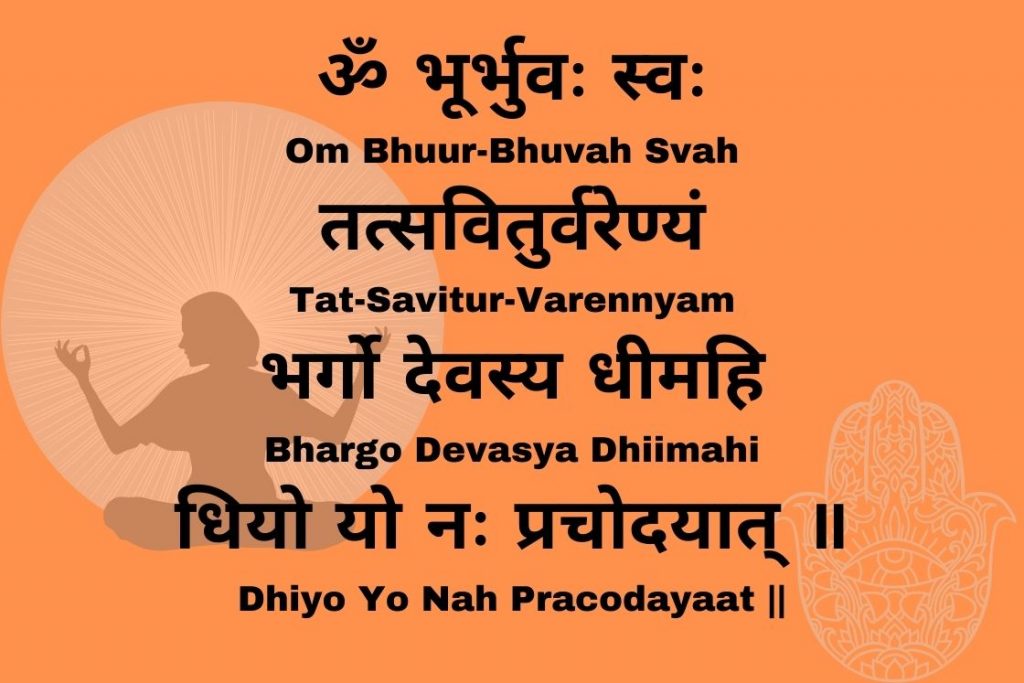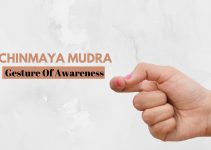
The Gayatri mantra is considered to be the most powerful mantra mentioned in the Vedas.
The Hindu goddess “Gayatri,” who stands for the relentless quest for wisdom, is the inspiration behind the naming of the Gayatri mantra. Gayatri is depicted in Vedic literature as the sun’s radiance in feminine form.
Thus, the Gayatri mantra is the source of the sun’s energy chanting which activates the solar energy or Pingala Nadi in the body. It should be chanted facing the east direction in the morning and afternoon and towards the west in the evening.
What Are Gayatri Mudras?
To enhance the power of the Gayatri mantra, there are a set of 32 mudras that are performed before and after chanting this mantra, known as Gayatri Mudras. The body receives life-giving energy when the Gayatri Mudras are performed repeatedly because this keeps the body’s positive and negative cells from combining.
The 32 Gayatri mudras are symbolic representations of the 32 vertebrae columns of the spine. The spine is the focal point of the 72000 Nadis that further branches to the rest of the body. The 7 chakras are also present in the spinal column in our subtle body (Sukshama Sharira).
When the blood circulates through these channels, it gives strength to the body, destroys the bad cells, removes blockages, and provides us immunity.
Once all these mudras are performed, you should chant the Gayatri mantra at least 10 times with your hands in the Gyan mudra.
These 32 Gayatri mudras are divided into poorva mudra and uttara mudra. Let us learn about them in detail.
Also read: Meaning and Benefits of Chanting Gayatri Mantra
Poorva Mudras
The first 24 mudras out of the 32 mudras, also known as Poorva Mudras, are performed before chanting the Gayatri mantra. These mudras should be performed in front of a divine symbol or the statue of Gayatri.
Out of the 24 mudras, the first 17 are focused on Pancha bhutus or Five elements of the body. They cleanse, stimulate, and balance the panch tattva or 5 elements which further activate the Nadis and chakras.
Also read: Nadis and Chakras – The Flow of Prana in Subtle Body
1. Sumukham Mudra
This hand gesture signifies the formation of life. It reflects the energy of Iccha (desire) and a state before nature is formed (ekam)

Steps to perform
- Face your palms towards each other.
- Join the tips of all the fingers to the tips of the thumb in both hands.
- Now join both hands together by touching the tips of all the fingers.
2. Samputam Mudra
This hand gesture represents the formation of a “bud”. It represents the formation of absolute knowledge in a human’s soul.

Steps to perform
- From sumukham, straighten all your finger till the pads of your fingers are touching each other.
- The thumbs are kept next to each other, touching at the sides while the base of the palms should be touching.
3. Vitatam Mudra
This mudra signifies the blossoming stage of the bud. It is the conversion of the energy of iccha to the energy of kriya.

Steps to perform
Keeping the same formation of the fingers as in samputam, separate the hands slightly till there is a small gap between the palms. None of your fingers or the palm should be touching each other.
4. Vistrutam Mudra
The bud is ready to bloom fully. This mudra also signifies the expansion of the universe or cosmos.

Steps to perform
Straighten your fingers while widening the gap between the palms. Your fingers should now slant away from each other.
While performing above 4 mudras, this mantra is chanted.
Athaha Param Pravakshyaami Varnaa Mudraaha Kramenatu |
Sumukham Samputam Chaiva Vitatam Vistrutam Tatha ||
5. Dvimukham Mudra
In Sanskrit, dvi means two and mukham means faces. This mudra is a reminder of the dual faces of brahman- prakruti and purusha.

Steps to perform
Spread your fingers and join the tips of the ring and little fingers. The rest of the fingers and thumbs are away from each other.
6. Trimukham Mudra
Tri means three in Sanskrit. Thus, this mudra denotes the combined energy of iccha, gnana, and kriya. It also represents the 3 natures of Brahma, Vishnu, and Mahesh or Shiva.

Steps to perform
While making the dvimukham, join the tips of the middle finger as well.
7. Chaturmukham Mudra
Chatur is four in Sanskrit. This mudra is symbolic of the 4 Vedas – Rigveda, Yajurveda, Samaveda, and Atharvaveda. It also denotes the 4 purusharthas (object of human pursuits) – Dharma (righteousness), Ardha (economics), Kama (pleasure), and Moksha (liberation).

Steps to perform
In continuation with the above mudra, join the tips of index fingers as well.
8. Panchamukham Mudra
Panch means five in Sanskrit. This represents the panch tattvas or 5 basic elements that make up every living being – space or ether, air, fire, water, and earth.

Steps to perform
Join the tips of the thumb such that all the fingertips of both hands are touching each other.
9. Shanmukham Mudra
This mudra is dedicated to Lord Shanmukam or more commonly known as Karthikeya or Subramanya. He is the son of Lord Shiva and Goddess Parvati and it is said that they had to perform severs tapas for him. Thus, this mudra helps us understand the importance of tapas and also reflects the youngness of nature.

Steps to perform
Keeping the above mudra intact, only separate the tips of both little fingers.
10. Adhomukham Mudra
Through this mudra, you are reflecting on the jnanendriyas (sense organs) and karmendriyas (organs of action). It also shows the downward path of nature’s process.

Steps to perform
Bend your fingers such that they are pointed towards you and keep the thumb extended upwards. Bring your hands together so that the back of the fingers are touching each other.
11. Vyaapakaanjali Mudra
Here, you are reflecting on the expansion of nature. It is also the gesture of all-pervading offering or invocation to the divine.

Steps to perform
From the above mudra, roll your hands to the front so that your hands are laid flat next to each other, fingers are pointing straight, and palms are facing upwards. Keep them together by placing the sides of the little fingers together.
12. Sakatam Mudra
This hand gesture symbolizes the chakras in conjunction with the movements in the body.

Steps to perform
Curl the fingers of both hands into a fist except for the index finger and thumb. Join the tips of both thumbs while keeping the index fingers straight and pointing to the front. The formation should look like “I_I” with palms facing down.
13. Yamaapasam Mudra
This mudra denotes death or to stop. It is also said to balance the Ida and Pingala Nadis while teaching you the cycle of life and death.

Steps to perform
Curl your fingers, except the index fingers, and slightly rest your thumb on the top of curled fingers. Interlock the index fingers to form a chain or link that is pulling at each other.
14. Granthitam Mudra
This mudra signifies the coming together of all the panch tattvas and the moment you finally unite into God.

Steps to perform
Place your palms together facing each other (namaste formation). Bend each finger through the gaps to interlock your fingers.
15. Sanmukhonmukham Mudra
This gesture also represents the unification of jeevatma into the paramatma.
Steps to perform
This mudra finger formation will be the same as sumukham. You will then turn your hands in a way that the right hand comes on top of the left hand. The palm of the left hand should face upwards.
16. Pralambam Mudra
This mudra represents the path you undertake or the many lives you go through to attain moksha or liberation, which is extremely long.

Steps to perform
Both the palms of the hand should be facing down. The fingers should be kept straight and pointed to the front. The hands should be placed next to each other. The formation is similar to the gesture when a Hindu priest or an adult gives aashirwad (blessing) to the one touching their feet.
17. Mushtikam Mudra
Through this gesture, you will be eliminating ignorance.

Steps to perform
Curl your fingers to form a fist with the thumbs placed on the side of the curled index finger. Join the hand at the middle phalanges with the thumbs joined at the sides.
18. Matsyam Mudra
Matsya means fish in Sanskrit. The fish is also considered to be an incarnation of Lord Vishnu. It helps with mental stability and forgetfulness.

Steps to perform
Place the right hand on top of the left hand, both palms facing down. The fingers are kept straight while the thumb is extended sideways. This hand formation looks like a fish.
19. Koormam Mudra
Koorma means turtle, that withdraws into its shell for restoration and safety. Similarly, this mudra encourages us to turn inwards and self-awareness. It gives us the courage to handle responsibilities and difficult situations.

Steps to perform
Curl the middle and ring finger of the right hand while keeping the other fingers straight. Place this hand on the left palm such that the thumb is placed on the middle of the left wrist.
The index finger of the right hand should be placed on top of the left thumb and the tip of the right hand’s little finger should touch the tip of the left hand’s index finger.
The remaining fingers of the left hand should be wrapped around the edge of the right hand.
20. Varaahakam Mudra
This mudra shows you the way through troubled and confusing situations. It gives you the confidence to tackle impossible tasks.

Steps to perform
Place your hands in the matsyam mudra. Slightly bend the index, middle, and ring fingers of both hands down. The little finger and thumbs should be extended straight and spread sideways.
21. Simha Krantam Mudra

Steps to perform
Bring your hand near your ears and face the palms to the front. Keep your fingers straight and pointed upwards. The forearms should be parallel to each other with elbows pointed down.
22. Mahakrantam Mudra
This mudra shows the attainment of immense knowledge after ignorance is eliminated.

Steps to perform
From the above mudra, turn your hands so that the palms are facing the back.
23. Mudgaram Mudra
This mudra signifies the weapon of destruction of the universe. Physically it helps eliminate diabetes and its related ailments.

Steps to perform
Form a fist in your right hand and bring the hand at eye level in front of you. Place the right elbow on top of the left palm. The right forearm should be straight and the right palm should be facing forward.
24. Pallavam Mudra
This mudra is another name for abhaya mudra which is practiced to diminish fearlessness and develop courage. It invokes safety, protection, peace, and reassurance during challenging times.

Steps to perform
Hold the right hand at shoulder height with palms facing forward and ring and little fingers slightly bent.
Uttara Mudra
These 8 mudras, according to rigveda and yajurveda, are performed after sandhya upasana (spiritual practice done during the evening) and after the poorna mudras. These mudras activate nerves and give peace of mind.
Once you have completed performing these mudras, take some water in your right hand and let them seep through the gaps between the fingers while chanting tatsat brahmaarpana matsu.
1. Surabhi Mudra
The fingers used in the Surabhi Mudra represent the cow’s udders and are titled after Surabhi, the daughter of the sacred cow Kamadhenu. It is additionally referred to as the “wish-fulfilling” mudra.

Steps to perform
- Join the left hand’s little finger to the right hand’s ring finger at the tip.
- Join the little finger of your right hand and the tip of your left ring finger.
- Bring the middle fingers of the opposing hands together so that they touch the index fingers.
- Pointing in the direction of the heart, move the thumbs away from the fingers.
2. Gnanam Mudra
Gnanam or gyan mudra is the gesture of intuitive knowledge. It improves concentration and memory, brings awareness, and relaxes the nervous system.

Steps to perform
Join the tips of the index finger and thumb. With this formation, place your right hand, palms facing inwards, at the center of the chest. The left hand will be kept on the left knee, with palms facing up.
3. Vyraagya Mudra
This mudra will help you come out of a state of trance. It signifies detachment from worldly and material affairs.

Steps to perform
The hand formation is similar to the gnanam mudra with the difference of placing the hands on the thighs instead of the thighs.
4. Yoni Mudra

5. Sankha Mudra
The conch shell horn, which is used to proclaim the opening of temple doors in the morning, is represented by the mudra. The Shankh Mudra purifies the body and the soul and is a reflection of illuminating the inner temple with divine light.

Steps to perform
- All four fingers of the right hand should be curled around the left thumb.
- Connect the left hand’s middle finger with the right thumb.
- Keep the left hand’s fingers comfortably extended and together so that when you join them, they resemble the conch shell shape.
6. Pankajam Mudra
This mudra targets the crown mudra which is represented by a thousand-petaled lotus. It helps in generating knowledge of previous life.

Steps to perform
Bring your palms in namaste formation. Keeping the base of the palms joined along with the sides of the thumb and little finger, spread the remaining fingers away from each other. The hand formation should look like a blossoming flower.
7. Lingam Mudra
This mudra represents the power of Lord Shiva. Lingam or linga is the Sanskrit word for phallus or penis. Lord Shiva is often depicted and worshipped in the form of Lingeshwara and is a sign of masculinity. It frequently goes with yoni mudra and is also a symbol of rejuvenation. This helps in uniting with the shakti that flows from the root chakra to the crown chakra.

Steps to perform
Interlock your fingers with palms together but keep the right thumb extended upwards.
8. Nirvaanam Mudra
The calming serenity of realization is achieved by the Nirvana Mudra, also known as the mudra of liberty. This mudra specifically aids in the letting go that is necessary to achieve liberty. It is extremely beneficial for ego release.

Steps to perform
Bring your palms to face each other keeping a slight distance between them. Now cross your hands so that the right hand is on the left side and the left hand is on the right side. Turn your hands inwards and join the palms.
Check the video below to see how Gayatri mudras are performed in sequence.





Namaste 🙏
It’s been so informative and enlightening to go through the Gayatri Mudras…
I am delighted to have found these..
Thanks to You immensely…
🙏🙏🙏
Mr Ashish
I wish to use the Gayantri Mantra Image and require your approval.